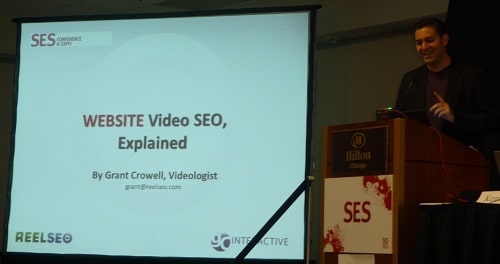In continuing AIMCLEAR coverage of #SESCHI, the morning of Day 2 found us in the info-packed Video Search Optimization session. Rich presentations by Greg Jarboe of SEO-PR, Grant Crowell of ReelSEO.com, and Paul Carff of Google were moderated by Anne F. Kennedy, SES Advisory Board, International Search Strategist, Beyond Ink USA. Whether you were video SEO savvy or totally n00btastic, this was a super informative & not-to-be-missed session. AIMCLEAR live-tweeted the session (via @aengleson)- read on for full coverage.Greg Jarboe hit the stage first, offering a general though valuable outline of video search optimization (with a focus on YouTube, which gets 24 hours of new content every minute, by the way…). Here’s a run-through of his biggest takeaways:
- In regards to the “Related Videos” section of YouTube…
- Google uses text-matching (using the video headline, captions, and description) to find videos that are important and/or relevent to the current video.
- Google also looks at the total number of views and video  ratings to determine quality and match.
- The easiest way to find terms that will relate well to current videos is to use the autofill search, which auto-completes using terms and phrases that have been recently searched for in YouTube.
- There is also a YouTube keyword tool that will suggest keywords based on given terms or even current videos.
- If you must have a brand within your video title, put it at the end.
- Integrating the target search term in the title is best.
- Fluffy titles like “Walking on the beach” does nothing for you if you are advertising hotels in Aruba.
- Put the target search terms in the video description as well.
- Use the description to really capture the long tail of video search.
- Try and create related videos that will show up in the sidebar.
- Most YouTube viewers watch about 6 videos in a batch, not just a single one. Â Having related videos helps keep the audience in your space.
- The video metadata that shows up in Google search is the video title, length, date, and a thumbnail.
- Enabling an expiration date of videos (where applicable) will help to keep only recent and/or relevant videos in your video sitemap.
- YouTube likes it when users provide extra metadata to their videos…
- Examples are content location, player location, duration, expiration date, publication date, and country restrictions [if your video is illegal to view in certain places].
- Adding this data will make YouTube happy and also give you a boost in Google search.
- The most common problem with getting video indexed in YouTube (after submitting a video sitemap) is if your site is blocking GoogleBot.
- Make sure you allow the bot, have unique video URL’s, and ensure that your content is visible on the play page.
- There are advantages to not hosting your videos on YouTube
- Better targeting capabilities
- More control over video & thumbnail
- No competition, no revenue share, and no takedowns
- Try using a video management tool such as BrightCove to manage all of your video assets, and get access to custom video players.
- Video creation can be as simple or complicated as you want.
- You can use professional videographers
- Hire video talent
- Conduct guest interviews
- Make use of Vloggers
- Post user-generated videos
- Even post webcam material
- Q: Does video age matter?
- A: Greg Jarboe pointed out that new videos do in fact get a boost. Â The first 3 days are precious in terms being the most visible. Â If you miss that window or need a boost, editing your video title or description will make Youtube think it is a new video again.
- Q: What type of thumbnails create the most clicks?
- A: The panel agreed that people like faces the best and text is a definite no-no.
- Q: What are some video description best practices?
- Paul Carff concluded that it must be of good quality, be relevant, timely & original.
- Grant Crowell recommended using phrases such as “Top 10” or “Best” to grab user attention and take advantage of curiosity.
- Greg Jarboe told the audience to simply create a story.
Hat-tip to the panel for an awesomely informative session on video search optimization. Stay tuned on AIMCLEAR blog for more coverage of #SESCHI & live-tweet coverage from Lauren (@beebow), Lindsay (@lindsaylorraine) & myself (@aengleson).









